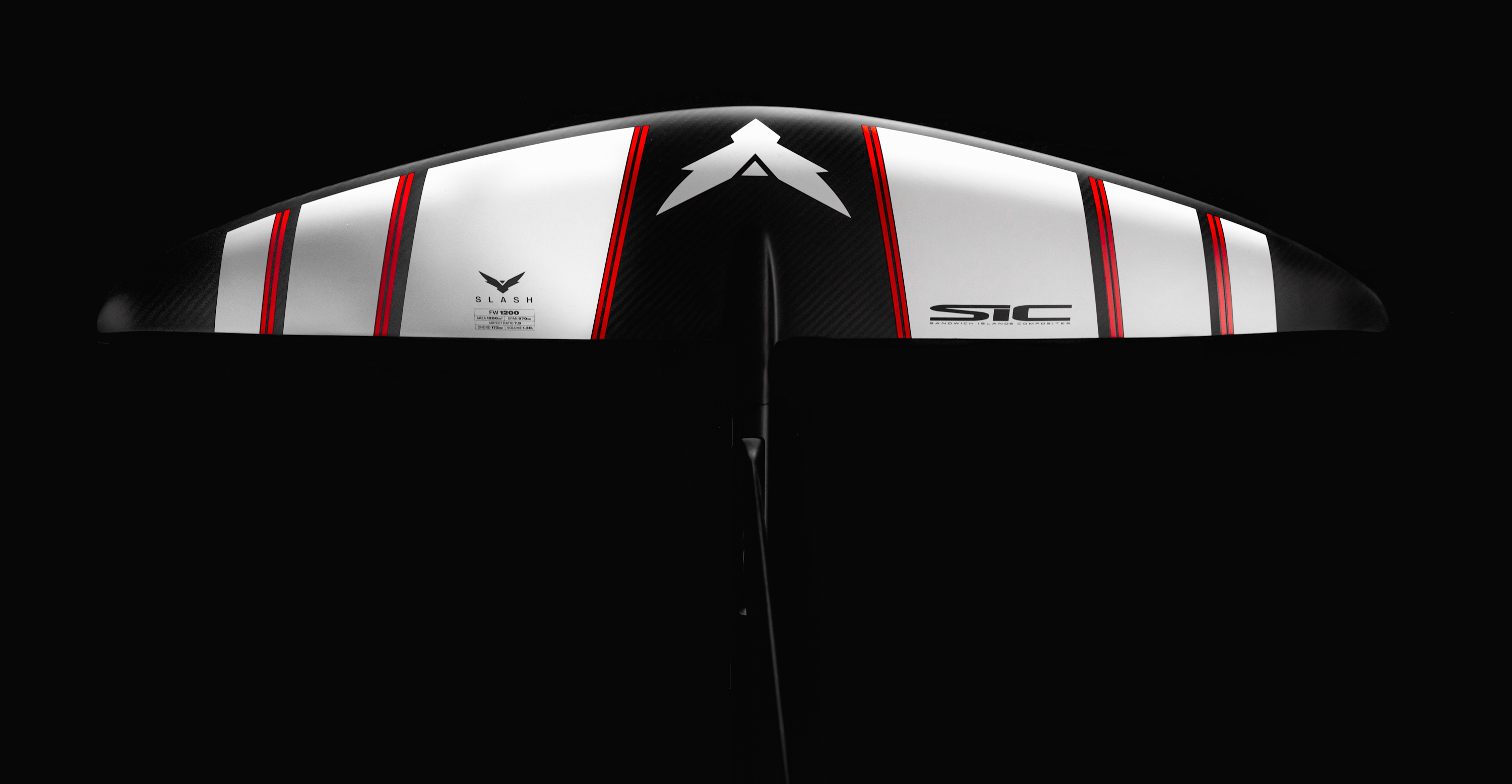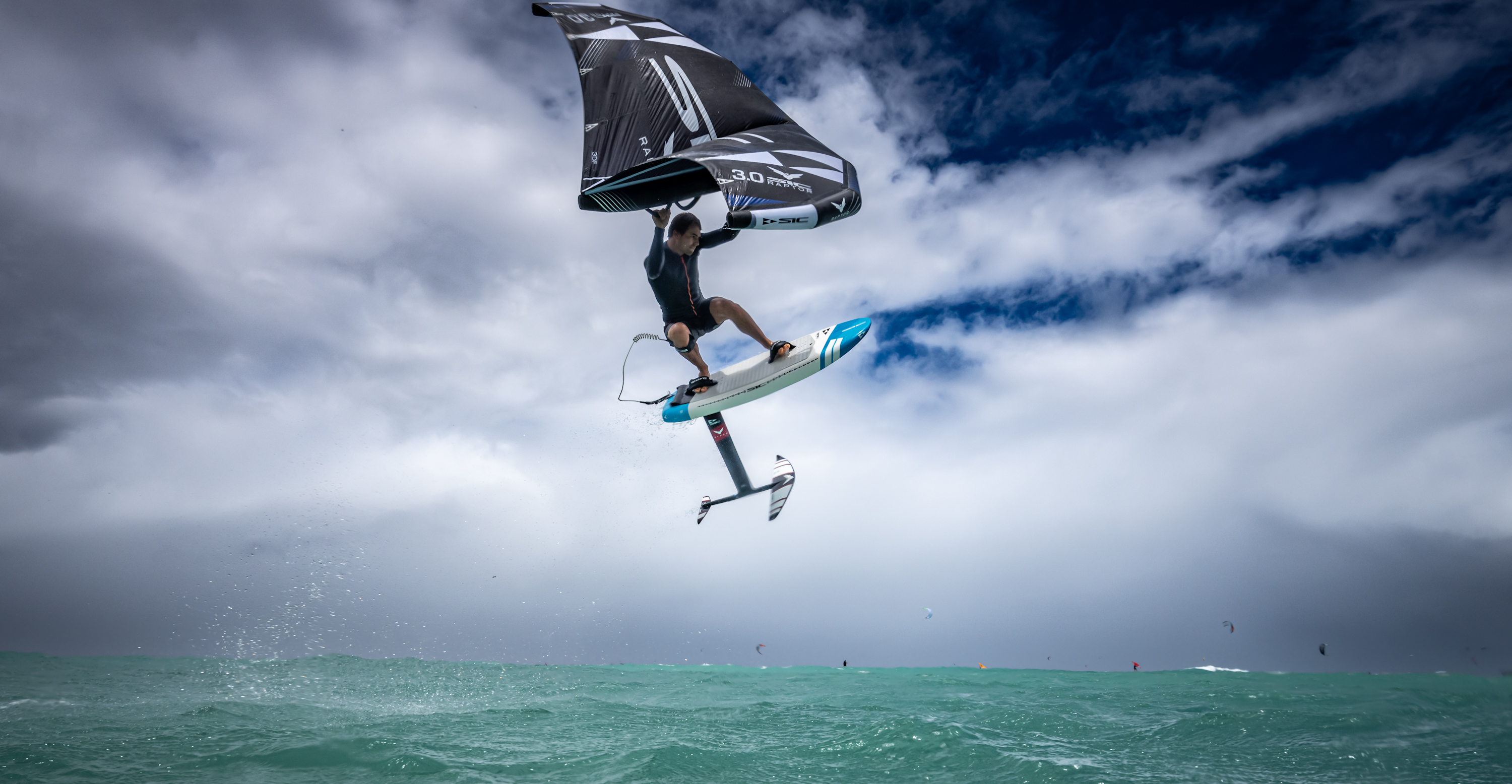Everything You Need to Know
About the Slash Foil
What is a foil board? In short, it’s a hydrofoil that is attached to the bottom of a surfboard. It operates like an airplane—an underwater fin with a winglike surface works to lift the board out of the water. When the board cuts through the water, the water flows faster above the surface than beneath it, creating a low-pressure zone on top, which generates lift. As speed increases, more lift is generated, allowing the board to lift out of the water. Hydrofoils can be used with surfboards, standup paddleboards, kites, windsurf boards, boats, and wakeboards—essentially anything that can be ridden in water.
When it comes to hydrofoils, SIC Maui is a trail blazer. A pivotal moment in watersports history, SIC introduced the Slash flip fuselage in 2022, allowing foilers to customize their riding performance. Designed for individuals looking to push wing foiling to the limit, the full carbon Slash range is all about delivering maximum glide, high-speed, and sharp turns. Multiple versatilities allow for maximum customization, enabling riders to tailor their set up according to their unique riding style.




Get To know the Slash Fuselage
The slash foil is comprised of five main parts: the mast, flip fuselage, front wing, fuselage cap, and the back wing.
MAST
The mast connects the wing to the board. Shorter masts are good for beginners to get used to lift height. They also work well for foiling in shallower water. Longer masts are designed for foiling in swell or chop as they help avoid touchdowns and provide better glide.
FRONT WINGS
Different size front wings will provide different performance capabilities, so it’s important to choose wisely. Larger/higher aspect front wings provide better glide, more lift, more stability, and better pumping. Smaller/lower aspect front wings, on the other hand, provide better turning. We suggest beginners opt for a larger front wing.
BACK WING
The fuselage cap allows you to connect to the backing. Similar to the front wing, different size back wings will also affect performance.
Larger back wings provide increased stability, more lift, and more drag, while smaller back wings increase speed and allow you to turn more easily.
SIC’s back wings also have winglets, which decrease drag at low speed and reduce the required speed for take-off on foils. Another perk of winglets is that they provide increased control, especially on turns.
SIC Maui back wings also have elongated screw holes that allow you to change the angle of attack by sliding the back wing forward or backward. Shift the back wing backward and achieve more speed. Shift the back wing forward and achieve more lift.
FLIP FUSELAGE
The flip fuselage connects the mast to the wings. The Slash comes with an asymmetrical flip fuselage, which allows you to change the riding characteristics of your foil.
To get started, we recommend setting up your flip fuselage with the pump arrow facing the front wing.
Facing the pump arrow forward creates more distance between the mast and the front wing, allowing for pump riding style, more lift, better stability, and more control.
On the flip side, facing the steering wheel forward will create less distance between the mast and front wing, allowing for more maneuverability and more aggressive turns.
Everything you need to know about setting up your slash foil system is right here in our SIC Education series. The Slash range in full carbon is all about maximum glide, high-speed, and hard carving for those who want to push Wing Foiling to the maximum. Multiple versatilities for maximum customization according to riding styles.
Where you mount your slash foil set in the foil track is equally as important as choosing what size front and back wing to use. We recommend setting your mast in the center of the foil tracks to get started. Moving your mast forward will provide more lift and more front foot pressure; moving it back will provide less lift and more back foot pressure but will also reduce drag and increase max speed. Movements should be done in small increments to find the perfect spot of controlled lift.


Caring For Your Slash Foil


Taking good care of your foil will help ensure your equipment functions properly for years to come. After each use, disassemble your foil completely to prevent oxidation of the screws and threads and wash each component in freshwater. It’s also important to protect the front wing and stabilizer with dedicated covers when not in use. If you are not using your foil for a prolonged period, we recommend you fully disassemble the foil system, rinse with fresh water, and dry it.
Did you know?
Foiling may seem like a relatively new sport but in reality, it’s been around for over a hundred years. In 1869, the first patent for the hydrofoil was constructed by Emmanuel Denis Fargot for a rowboat. In 1906, Enrico Forlanini designed the first hydrofoil boat, which hit a max speed of 36.9 knots. Over the years, engineers such as Alexander Graham Bell and the Wright brothers caught wind of the invention and began experimenting with foiling designs. In 1938, the first known sailing hydrofoil was created by R. Gilruth and Bill Carl, revolutionizing the future of water sports.
Over the years, the foil continued to progress but in 2003, Laird Hamilton popularized the hyrdrofoil as a viable sport via its appearance in Step into Liquid. In 2004, Mango Carafino designed the first hydrofoil for a kiteboard. In 2016, footage of Kai Lenny standup paddle hydrofoiling was released, causing foiling to further take off.




